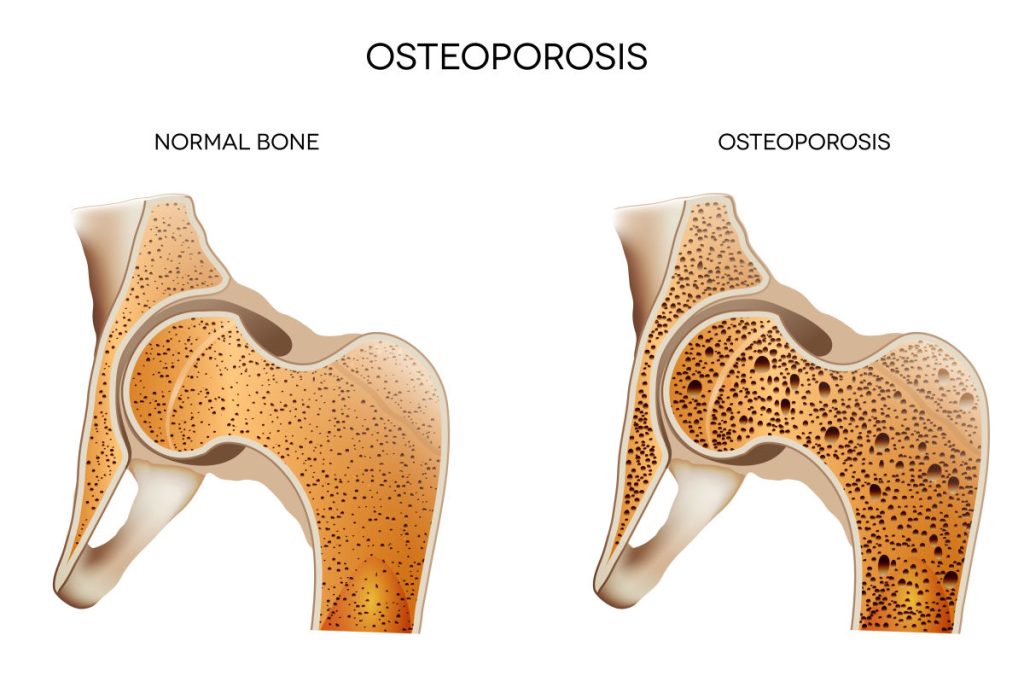
Osteoporosis is a condition characterized by low bone mass, skeletal fragility resulting in weak bones and a dramatic increase in fracture risk. It arises from an imbalance between bone formation and resorption leading to progressive bone loss. While often associated with women and menopause, it affects millions globally, regardless of age or gender. Early diagnosis and proactive intervention are crucial to prevent devastating fractures and improve quality of life.
Risk Factors
Several factors contribute to osteoporosis development, including:
- Hormonal Changes: Estrogen decline in women after menopause and testosterone deficiency in men play key roles.
- Aging: Bone production naturally declines with age, increasing osteoporosis risk.
- Genetic Predisposition: Family history significantly increases individual risk.
- Lifestyle Factors: Diet low in calcium and vitamin D, smoking, excessive alcohol intake, and physical inactivity contribute to bone loss.
- Medical Conditions: Certain conditions like rheumatoid arthritis, celiac disease, and hyperthyroidism can increase osteoporosis risk.
Diagnosis of Osteoporosis
- Dual-energy X-ray absorptiometry (DXA): The gold standard for diagnosis, measuring bone mineral density (BMD) at the hip and spine.
- Fracture Risk Assessment Tools: FRAX score helps predict 10-year fracture probability based on BMD, clinical risk factors, and country-specific data.
Osteoporosis Treatment Strategies
Lifestyle and medication play a crucial role in managing osteoporosis by slowing bone loss and reducing fracture risk. Treatment options are based on your individual risk factors, bone density, and overall health.
- Lifestyle Modifications:
- Calcium and Vitamin D Supplementation: Ensure adequate intake through diet and supplements. It is generally recommended to consume around 1200mg calcium through diet and supplementation, and 800units of vitamin D.
- Regular Weight-bearing Exercise: Strengthens bones and improves balance.Fall Prevention Measures: Reduce environmental hazards to prevent falls.
- Smoking Cessation: Smoking accelerates bone loss.
- Pharmacological Intervention:
- Bisphosphonates: Oldest form of medication which inhibits bone resorption and slows bone loss. Examples include alendronate (Fosamax), risedronate (Actonel), and zoledronic acid (Reclast).
- Denosumab (Prolia): A monoclonal antibody that inhibits RANKL, a protein that stimulates bone resorption. It is administered via injection every six months.Romosozumab (Evenity): A monoclonal antibody that inhibits Sclerostin, a protein that stops bone formation. It is administered via injection once a month for 12 months.Teriparatide (Forteo) and Abaloparatide (Tymlos): A synthetic form of parathyroid hormone that stimulates bone formation. It is administered via daily injection.
- Selective Estrogen Receptor Modulators (SERMs): Raloxifene (Evista) is a SERM that helps prevent bone loss in postmenopausal women.
References
- Rosen CJ. Clinical practice. Postmenopausal osteoporosis. N Engl J Med 2005; 353:595.
- https://www.uptodate.com/contents/table-of-contents/rheumatology/osteoporosis
- Saag, K. G., Petersen, J., Brandi, M. L., Karaplis, A. C., Lorentzon, M., Thomas, T., … & Maddox, J. (2017). Romosozumab or alendronate for fracture prevention in women with osteoporosis. New England Journal of Medicine, 377(15), 1417-1427.






